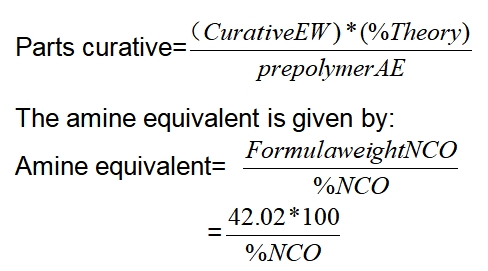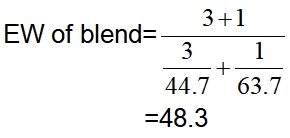 Calculation
Calculation
There are different ways of doing the calculations. Most commonly used methods are the %NCO and the amine equivalent method.br/>
 %NCO Method
%NCO Method
The calculation is to determine the amount of curative needed for 100 parts by weight of the prepolymer.

Where
%NCO is the amount of terminal isocyanate in the prepolymer and is supplied by the manufacturer and is marked on the can
EW curative is supplied by the manufacturer of the curative
EW NCO is the equivalent weight of the isocyanate group and is 42.02
%Theory is the variation required to give the best properties for the system
The formula is normally used in a simplified form. For example, if we are using MOCA as the curing agent and the index at 95%,

 Amine Equivalent Method
Amine Equivalent Method
The other method that is sometimes proposed is the “amine equivalent”(AE) method:

 Common Curatives
Common Curatives
Curative are used to enlarge the prepolymer chain either by extension or by cross-linking. Materials with two active groups will extend the length of the chain by joining two chains together. Triols will provide the means to form permanent covalent bonds between different chains.
| Type | Name | Equivalent Wt. |
| Diol | BDO | 45 |
| HQEE | 99.1 | |
| High M/W Diols | PPG1000 | 500 |
| PTMEG1000 | 500 | |
| Triols | TIPA | 63.7 |
| TMP | 44.7 | |
| Diamine | Ethacure E100 | 89.3 |
| Ethacure E300 | 107 | |
| M-CDEA | 187 | |
| MOCA(MBOCA) | 133.5 |
The equivalent weight of the blend must be calculated taking into account the individual equivalent weights.

For example, if a mixture of 3parts TMP is used with 1 parts of TIPA,

The above calculation gives a working EW of 48.3.
